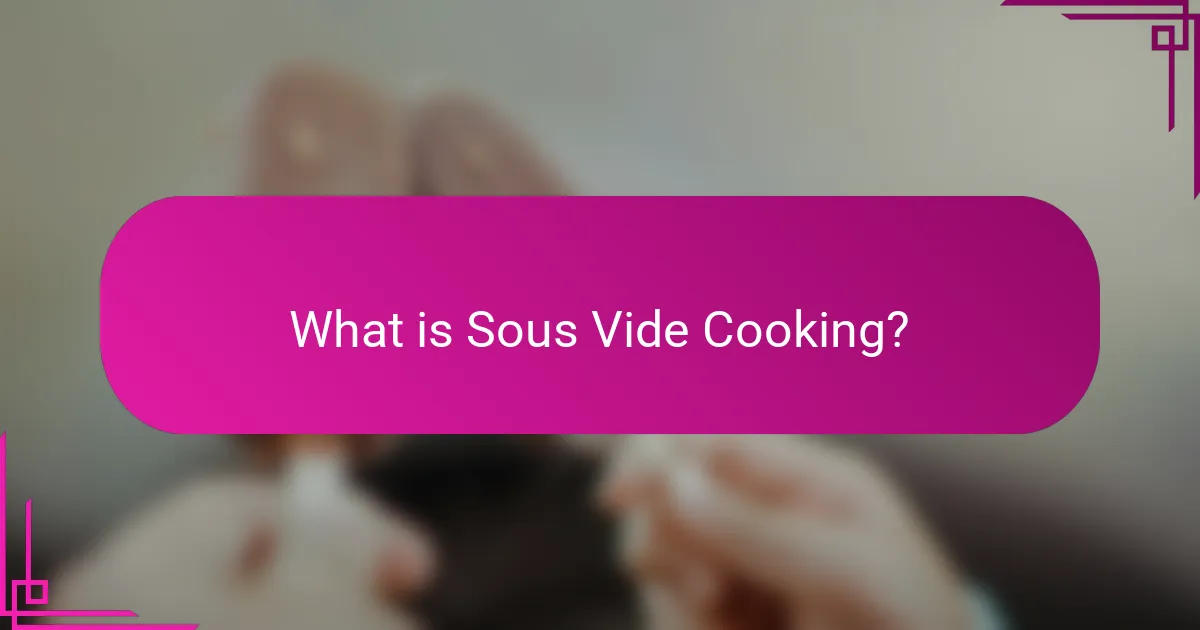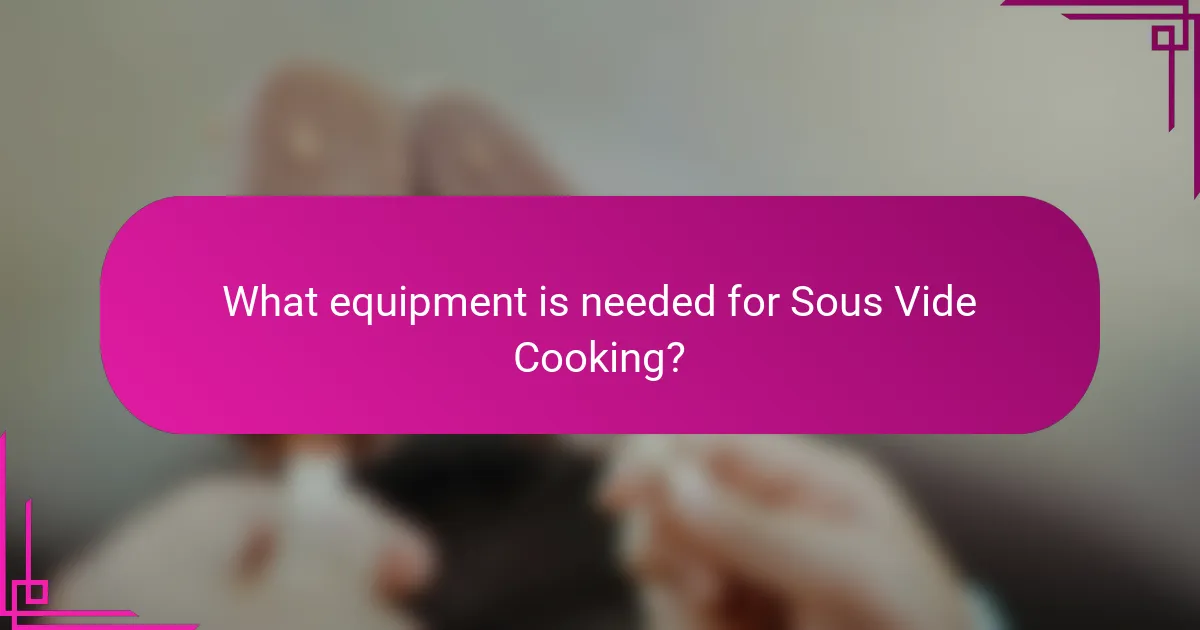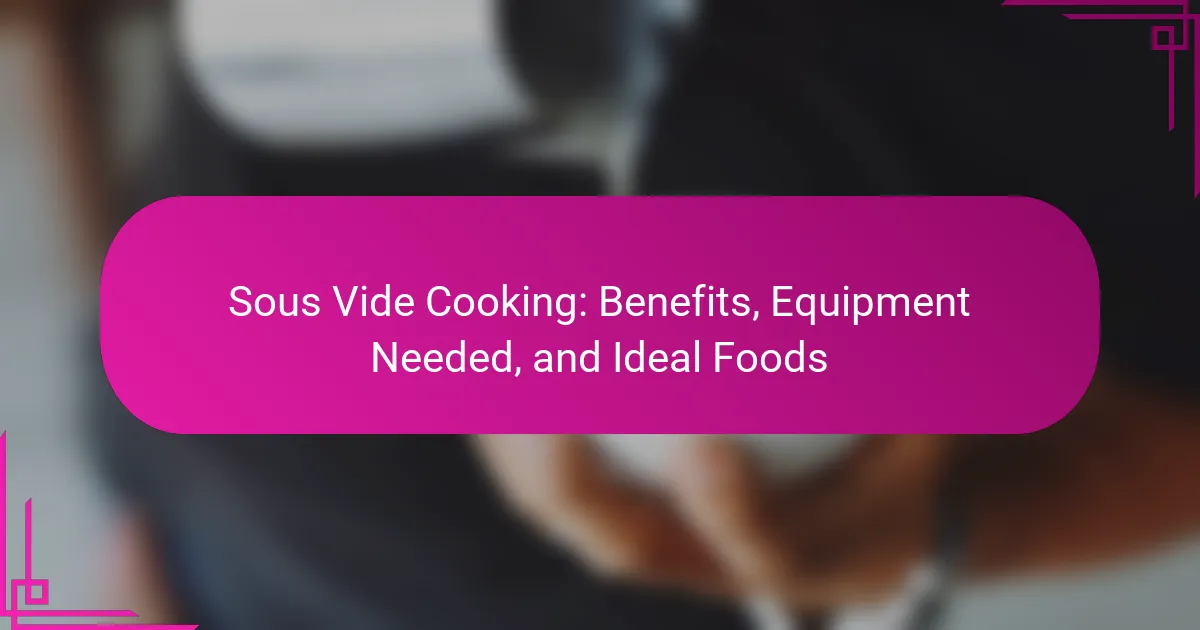Sous vide cooking is a precise culinary technique that involves cooking food in vacuum-sealed bags submerged in a controlled water bath. This method allows for even cooking and moisture retention, making it ideal for meats, vegetables, and eggs. Essential equipment includes a sous vide immersion circulator, vacuum-sealed bags, and a large container for water. The article explores the benefits of sous vide cooking, the necessary equipment, and the types of food that achieve optimal results using this technique. By maintaining consistent temperatures, sous vide enhances flavor and texture while minimizing the risk of overcooking.

What is Sous Vide Cooking?
Sous vide cooking is a method of cooking food in a vacuum-sealed bag submerged in a water bath. This technique allows for precise temperature control, ensuring that food is cooked evenly and retains moisture. Sous vide cooking typically involves cooking at lower temperatures for extended periods. For example, cooking a steak at 130°F for several hours results in a perfectly medium-rare finish. The method was popularized by chefs in the 1970s and has gained widespread use in both professional and home kitchens. The precision of sous vide cooking minimizes the risk of overcooking. It also enhances the flavors and textures of the food.
How does Sous Vide Cooking work?
Sous vide cooking involves vacuum-sealing food in a bag and cooking it in a water bath at a precise temperature. This method ensures even cooking and retains moisture and flavor. The water bath maintains a consistent temperature, allowing food to cook slowly and evenly. Sous vide can enhance the texture and tenderness of proteins. Cooking times can vary from one to 48 hours, depending on the food type. Foods cooked sous vide often require a final sear or finish for added flavor and texture. Scientific studies show that sous vide cooking can preserve nutrients better than traditional methods.
What are the essential components of Sous Vide Cooking?
The essential components of sous vide cooking include a vacuum sealer, sous vide immersion circulator, and water bath. A vacuum sealer removes air from bags containing food. This process helps prevent oxidation and enhances flavor. The sous vide immersion circulator heats and circulates water to maintain a precise temperature. Accurate temperature control is crucial for achieving desired doneness. The water bath holds the temperature consistently throughout the cooking process. This method allows for even cooking and retains moisture. These components work together to produce tender, flavorful dishes.
How does temperature control impact Sous Vide Cooking?
Temperature control is crucial in sous vide cooking. It ensures precise cooking at low temperatures over extended periods. This method allows for even cooking and prevents overcooking. Different foods require specific temperatures for optimal results. For example, cooking chicken at 140°F for 1.5 hours ensures safety and tenderness. Accurate temperature control also preserves nutrients and flavors. Studies show that sous vide cooking can enhance the texture of meats. Therefore, maintaining the correct temperature is essential for achieving the desired culinary outcomes.
What are the benefits of Sous Vide Cooking?
Sous vide cooking offers precise temperature control, resulting in evenly cooked food. This method enhances flavor retention and moisture, leading to tender dishes. It also minimizes nutrient loss compared to traditional cooking methods. Sous vide is convenient, allowing for meal prep in advance. The technique reduces the risk of overcooking, ensuring consistent results. Additionally, sous vide cooking can improve food safety by eliminating harmful bacteria through controlled cooking times. These benefits make sous vide a popular choice among chefs and home cooks alike.
How does Sous Vide Cooking enhance flavor and texture?
Sous vide cooking enhances flavor and texture by precisely controlling cooking temperatures. This method allows food to cook evenly and retain moisture. The vacuum-sealed bags prevent the escape of juices and flavors during cooking. As a result, proteins become tender and infused with seasonings. Research shows that sous vide can improve the overall taste experience. A study published in the Journal of Culinary Science & Technology found that sous vide cooking can enhance the flavor profile of meats significantly. This technique also allows for consistent results, ensuring that food is cooked to the desired doneness every time.
What health benefits are associated with Sous Vide Cooking?
Sous vide cooking offers several health benefits. It allows for precise temperature control, which can reduce the risk of overcooking. This method helps retain more nutrients in food compared to traditional cooking methods. Studies indicate that sous vide can preserve vitamins and minerals better, particularly in vegetables. The low-temperature cooking process also minimizes the formation of harmful compounds that can occur at higher temperatures. Additionally, sous vide cooking can enhance food safety by ensuring that food reaches a safe internal temperature without overcooking. These health benefits make sous vide a preferred cooking technique for health-conscious individuals.

What equipment is needed for Sous Vide Cooking?
Sous vide cooking requires a few essential pieces of equipment. The primary equipment is a sous vide immersion circulator. This device heats water to a precise temperature for cooking food evenly. A large container or pot is also needed to hold the water and the food. Vacuum-sealed bags or zip-top bags are necessary for food storage during cooking. A vacuum sealer is often used to create airtight seals in the bags. Additionally, a digital food thermometer can be helpful to ensure food safety. These tools collectively enable effective sous vide cooking by maintaining consistent temperatures and preventing water contamination.
What are the essential tools for Sous Vide Cooking?
The essential tools for sous vide cooking include a sous vide immersion circulator, vacuum sealer, and heat-safe bags. The sous vide immersion circulator maintains the precise water temperature required for cooking. A vacuum sealer removes air from bags to ensure even cooking and prevent spoilage. Heat-safe bags are necessary for containing food while submerged in water. These tools work together to create a controlled cooking environment. Studies show that sous vide cooking can enhance flavor and texture by allowing for consistent results.
How do immersion circulators function?
Immersion circulators function by heating water to a precise temperature and circulating it. They maintain consistent temperature control throughout the cooking process. A heating element warms the water, while a pump circulates it to ensure even heat distribution. This method allows for precise cooking, which is essential in sous vide techniques. Immersion circulators can typically heat water to within 0.1 degrees Celsius accuracy. This precision results in evenly cooked food, retaining moisture and flavor. The device often features digital controls for easy temperature adjustments. Immersion circulators have gained popularity in both professional and home kitchens for their reliability and effectiveness.
What types of vacuum sealers are available?
There are three main types of vacuum sealers available: external vacuum sealers, chamber vacuum sealers, and handheld vacuum sealers. External vacuum sealers use a suction mechanism to remove air from bags before sealing. They are typically more affordable and suitable for home use. Chamber vacuum sealers remove air from a chamber, allowing for more efficient sealing of liquids and larger quantities. They are often used in commercial settings. Handheld vacuum sealers are portable devices that are ideal for quick sealing tasks and smaller items. Each type serves different needs in food preservation and sous vide cooking.
What additional accessories enhance Sous Vide Cooking?
Additional accessories that enhance sous vide cooking include vacuum sealers, immersion circulators, and sous vide bags. Vacuum sealers create airtight packaging for food, improving heat transfer and flavor infusion. Immersion circulators maintain precise water temperatures for consistent cooking results. Sous vide bags are designed to withstand high temperatures and prevent leaks during cooking. Other useful accessories are clip racks, which secure bags in place, and food thermometers, ensuring food reaches the desired doneness. These accessories collectively improve the sous vide cooking experience by enhancing efficiency and quality.
How do sous vide bags differ from regular cooking bags?
Sous vide bags differ from regular cooking bags in material and purpose. Sous vide bags are designed to withstand high temperatures and vacuum sealing. They are typically made from BPA-free polyethylene or nylon. This construction ensures they remain intact during prolonged cooking times in water baths. Regular cooking bags, such as those for roasting, may not handle the same heat or vacuum pressure. They can melt or release harmful chemicals when exposed to high temperatures. Sous vide bags also have a tighter seal to prevent water from entering, ensuring food cooks evenly. This specificity makes them ideal for sous vide cooking techniques.
What role do containers play in Sous Vide Cooking?
Containers are essential in sous vide cooking as they hold the food and water during the cooking process. They ensure even heat distribution around the food, which is crucial for achieving precise temperature control. The containers must be heat-resistant and capable of withstanding prolonged cooking times. Common choices include vacuum-sealed bags, jars, and food-safe plastic containers. The right container also prevents water evaporation, maintaining consistent cooking conditions. Additionally, containers help to prevent contamination and preserve food quality. Using proper containers is vital for safety and effectiveness in sous vide cooking.

What foods are ideal for Sous Vide Cooking?
Sous vide cooking is ideal for meats, vegetables, and eggs. Meats like steak, chicken, and pork benefit from precise temperature control. This method enhances tenderness and flavor while ensuring even cooking. Vegetables retain their nutrients and texture when cooked sous vide. Eggs achieve perfect consistency, whether soft or hard-boiled. Fish, particularly delicate varieties like salmon, also excel in sous vide due to controlled cooking temperatures. Root vegetables, such as carrots and potatoes, develop rich flavors through this technique. Overall, sous vide cooking is versatile, yielding consistent and high-quality results across various food types.
Which proteins are best suited for Sous Vide Cooking?
The proteins best suited for Sous Vide cooking include beef, chicken, pork, and fish. Beef cuts like ribeye and flank steak benefit from precise temperature control. Chicken remains juicy and tender when cooked sous vide. Pork loin and belly achieve optimal texture and flavor through this method. Fish, such as salmon and tuna, retain moisture and enhance taste with sous vide cooking. These proteins respond well to the low and slow cooking process, ensuring even doneness. Sous Vide allows for consistent results, making it ideal for these protein types.
How does Sous Vide Cooking affect the texture of meats?
Sous vide cooking significantly improves the texture of meats. This method involves cooking food in a vacuum-sealed bag submerged in a water bath at a precisely controlled temperature. The low and slow cooking process allows proteins to break down gently. This results in meats that are tender and juicy. Traditional cooking methods often lead to overcooking and dryness. In contrast, sous vide maintains moisture and enhances flavor retention. Studies show that sous vide can produce meats with a more desirable mouthfeel. This method also reduces the risk of tough textures associated with high-heat cooking.
What seafood options work well with Sous Vide Cooking?
Salmon, shrimp, scallops, and tuna are excellent seafood options for sous vide cooking. These seafood types benefit from precise temperature control. Salmon cooks evenly at temperatures between 122°F and 140°F. Shrimp can be cooked at around 140°F for optimal tenderness. Scallops are best cooked at 123°F for a sweet, buttery texture. Tuna is ideal at 125°F for a medium-rare finish. Sous vide cooking enhances flavors and maintains moisture in these seafood options.
What vegetables can be cooked using Sous Vide methods?
Sous vide methods can be used to cook a variety of vegetables. Common vegetables include carrots, potatoes, asparagus, and beets. These vegetables retain their flavor and nutrients when cooked sous vide. Cooking times and temperatures can vary based on the vegetable type. For example, carrots are often cooked at 183°F for 1 to 2 hours. Potatoes can be cooked at 194°F for 1 to 2 hours. Asparagus typically cooks at 180°F for about 10 to 15 minutes. Beets may require a longer cooking time at 185°F for 2 to 3 hours. This method ensures consistent texture and taste.
How does Sous Vide Cooking preserve nutrients in vegetables?
Sous vide cooking preserves nutrients in vegetables by using low temperatures and vacuum-sealed bags. This method minimizes exposure to air and water, which can cause nutrient loss. Cooking at controlled temperatures, typically between 130°F to 185°F, reduces the degradation of vitamins and minerals. Studies show that sous vide can retain up to 90% of certain nutrients compared to traditional boiling methods. The vacuum sealing prevents leaching, ensuring that nutrients stay within the food. This technique results in vibrant flavors and textures while maintaining nutritional integrity.
What are the best techniques for cooking vegetables sous vide?
The best techniques for cooking vegetables sous vide include precise temperature control and vacuum sealing. First, select the appropriate temperature for the specific vegetable. For example, carrots are best cooked at 183°F for 1 to 1.5 hours. Next, vacuum seal the vegetables with seasonings to enhance flavor. This method preserves nutrients and prevents oxidation. Cooking in a water bath ensures even heat distribution. Finally, finish the vegetables with a quick sear for added texture. Studies show that sous vide cooking retains more vitamins compared to traditional methods, making it a healthier option.
What tips can enhance the Sous Vide Cooking experience?
To enhance the Sous Vide cooking experience, use high-quality vacuum-sealed bags. These bags ensure even cooking and prevent water from entering. Maintain precise temperature control with a reliable immersion circulator. This equipment guarantees consistent results. Preheat the water bath before adding food for optimal cooking. Experiment with different cooking times to discover your preferred doneness. Season food before sealing to infuse flavors during cooking. Use a finishing technique, such as searing, for better texture and presentation. Finally, monitor the cooking process with a timer for accuracy. These tips improve the overall Sous Vide experience significantly.
Sous vide cooking is a precise method that involves vacuum-sealing food in a bag and immersing it in a temperature-controlled water bath. This technique ensures even cooking, moisture retention, and enhanced flavors, making it popular among both professional chefs and home cooks. The article covers the essential equipment needed for sous vide cooking, including immersion circulators and vacuum sealers, as well as the ideal foods for this method, such as meats, seafood, and vegetables. Additionally, it discusses the health benefits associated with sous vide, including nutrient preservation and improved food safety.
